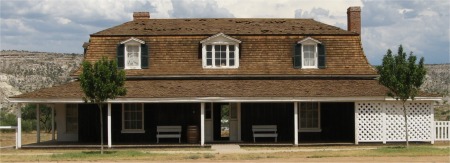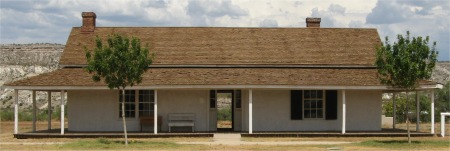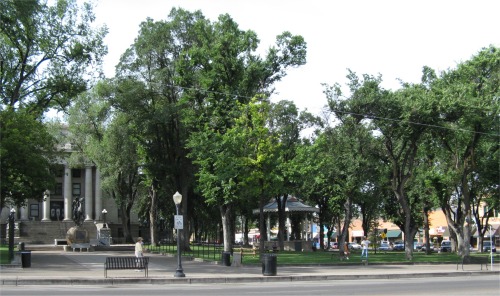 Prescott Plaza |
The city had its beginnings in the spring of 1863, when a party of explorers and would be gold miners led by the famed Joseph R. Walker arrived near the headwaters of the Hassayampa River. On 10th May 1863, at a location some six miles south-southeast of the city Plaza, 25 members of the Walker Prospecting and Mining Company adopted "Laws and Resolutions" governing members of the first mining district in what would later become Yavapai County. The rules for the "Pioneer Mining District" provided a foundation for the establishment of mining law in the central Arizona highlands, and could be considered Prescott's birth certificate.
Thus began a gold rush that sparked the settlement and development of central Arizona, and the choice of Prescott as the first Territorial capital. Before then, this area was almost totally unknown to white men, and gold mining prospects had been known only along the Colorado and Gila Rivers.
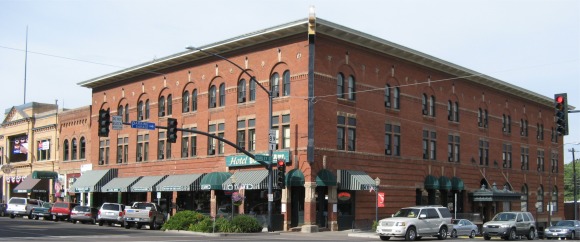 St Michael Building on Whiskey Row |
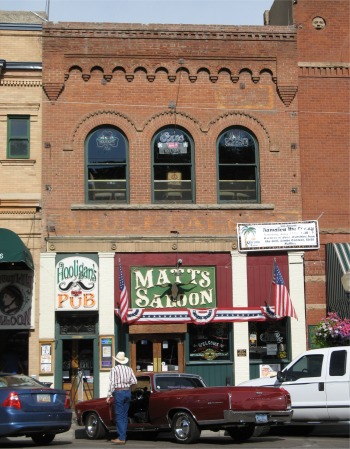 Matts Saloon |
The lady at the next table, who had been intently reading the business section of the New York Times, got up to leave and asked if I would care to read her paper. "Thank you very much", I replied. "it will be the first newspaper I will have read in over two months". She immediately deduced I was travelling and wished me a pleasant trip. Scanning through the paper, I learned that the BP oil well leak had finally been capped after spilling oil for 86 days. The nation's patience had been well and truly tried. Other news concerned the Argentine go-ahead for allowing same sex marriages, and for some reason a large coverage of the Belgium problem of forcing sectors to communicate primarily in either French or Flemish. A local piece of news, Arizona, which had been the first state to adopt photo enforcement of speeding laws, had become the first state to pull the plug that very morning, bowing to the wishes of a vocal band of conservative advocates who complained that photo enforcement intruded on privacy and was mainly devised to raise money.
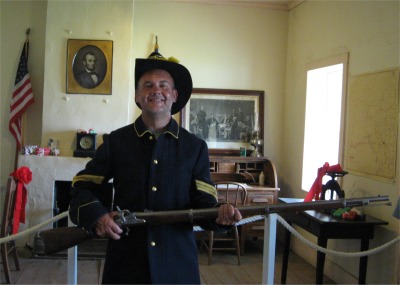 Officer Douglas with Top Button Undone - Court Marshall! |
The early volunteer military units were composed of almost entirely Mexican volunteers. Often marching barefoot and on half rations, they were known as fierce fighters. In August 1865 they established a tent camp overlooking the farms at West Clear Creek. Regular US Army troops relieved the Arizona Volunteers in September 1866. Camp Lincoln, the next post, was established December 1865, and was located one mile north of the present site, and was used from 1866 to 1871. In 1868 the name was changed to Camp Verde.
Malaria plagued the camp so much that in 1870, the Army made the decision to move again. Construction started at the present post in 1871, and all buildings were completed by 1873. There were 22 buildings arranged around a parade ground, only four of which had survived to this day, the rest had been sold off and broken up. Camp Verde had been renamed Fort Verde in 1879 to signify permanence, but with the end of raids by 1882, the Post became less important. It was abandoned in 1891.
|
|
|
|
|
|
|
The other three remaining buildings were Commanding Officer's Quarters, the Bachelor Officers' Quarters, and the Surgeon's Quarters. One interesting architectural feature was the construction technique. Traditional adobe construction used bricks made from a mixture of clay, sand and straw. However, the exterior walls of the building were made using "pice" construction. Here massive adobe units were cast in temporary wooden forms. This method was faster, simpler and less prone to water damage than the more traditional bricks.
I walked across the parade ground to take some photographs, and the heat on the skin was becoming painful. This was the furthest south I would be going in Arizona. I also noted storm clouds gathering around the ring of mountains surrounding Camp Verde.
On the way out of Camp Verde I pulled in at a supermarket to pick up provisions, and I could see lightening flashes all around the valley. When I was in the building, a lightening strike must have hit a power line since the supermarket lost all power. It was restored in a couple of minutes.
Montezuma Castle was only a few miles north and that would be my last port of call for the day. As I arrived, the storm was unleashing itself everywhere, and the rain was starting to fall. No sooner had I entered the visitor centre when the heavens opened up. It too took a power outage for a couple of minutes. One of the officials said that at this time of year, July/August, Arizona suffers its monsoon season. Normally single cell storms would give a localised downpour and that would be it. However, the current storm was unusual in that it was multicell, and instead of lasting minutes, this storm lasted an hour. I had a long chat with a lady who had just retired from her job as principal of a primary school, and her dad who had just retired for the third time. They were from Salt Lake City and were visiting some of the sights I had been to. It was a pleasure to advise on some of the locations such as Antelope Canyon and Canyon de Chelly.
 Fort Verde Parade Ground |
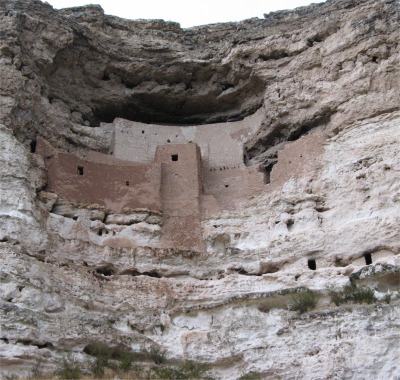 Montezuma Castle - Five Story Cliff Dwelling |
Dating from the 1100s, the pueblo remains that made up Montezuma Castle occupied an idyllic location, built into the limestone cliffs high above Beaver Creek. Once home to the Sinagua people, this cliff dwelling originally contained 20 rooms spread over five floors. Early settlers marveled at the structure and assumed that it was Aztec in origin, hence the name Montezuma Castle. Like Tuzigoot, Montezuma Castle reached its maximum size in the 1300s, and was occupied for another century before the Sinaguans abandoned the pueblo.
After taking it all in, I drove back to Flagstaff and found a campsite on the south side of the town for the night. My culinary concoction tonight was chilli followed by banana, a delightful combination. The site was a few thousand feet higher than the places I had visited earlier in the day, and the corresponding drop in temperature was most welcome. Tomorrow I would start heading west; go west old man!

